Antibiotics Market Size 2025-2029
The antibiotics market size is valued to increase USD 18.22 billion, at a CAGR of 5.9% from 2024 to 2029. Rising prevalence of infectious diseases will drive the antibiotics market.
Major Market Trends & Insights
- Asia dominated the market and accounted for a 42% growth during the forecast period.
- By Product - Broad-spectrum antibiotics segment was valued at USD 33.84 billion in 2023
- By Route Of Administration - Intravenous segment accounted for the largest market revenue share in 2023
Market Size & Forecast
- Market Opportunities: USD 67.19 billion
- Market Future Opportunities: USD 18.22 billion
- CAGR : 5.9%
- Asia: Largest market in 2023
Market Summary
- The market encompasses the production and distribution of antibiotics, a vital class of pharmaceuticals used to combat bacterial infections. This dynamic market is driven by the rising prevalence of infectious diseases and the growing demand for effective treatment options. According to the World Health Organization, antibiotic resistance is a major threat to public health, with an estimated 700,000 deaths annually due to drug-resistant infections. Core technologies and applications, such as the development of novel antibiotics and alternative delivery methods, are shaping the market's evolution. Strategic alliances and mergers and acquisitions, like Pfizer's acquisition of Arena Pharmaceuticals, are fostering innovation and consolidating market presence.
- However, high research and development costs and long development cycles pose significant challenges. Regional markets, including North America and Europe, dominate the landscape due to their advanced healthcare systems and robust research capabilities. Asia Pacific is expected to witness substantial growth due to increasing healthcare expenditures and a large population base. The market's continuous unfolding is influenced by these factors and the ongoing quest for effective antibiotics to combat antibiotic-resistant bacteria.
What will be the Size of the Antibiotics Market during the forecast period?
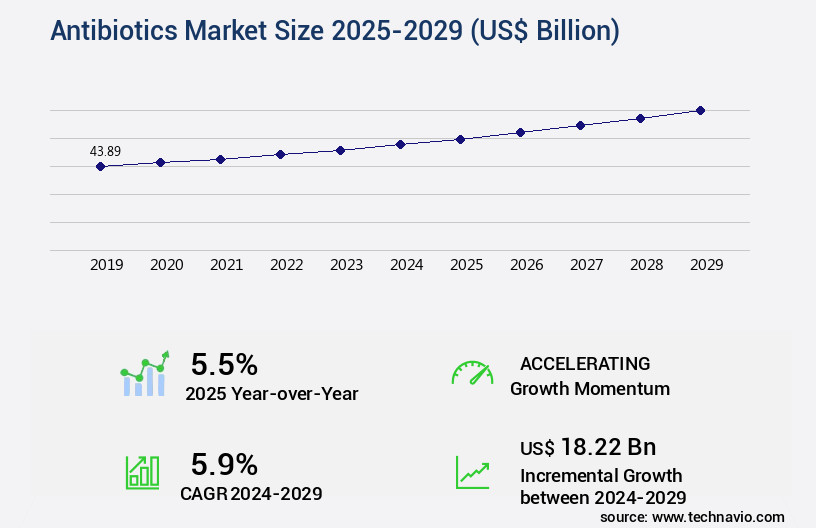
Get Key Insights on Market Forecast (PDF) Request Free Sample
How is the Antibiotics Market Segmented and what are the key trends of market segmentation?
The antibiotics industry research report provides comprehensive data (region-wise segment analysis), with forecasts and estimates in "USD billion" for the period 2025-2029, as well as historical data from 2019-2023 for the following segments.
- Product
- Broad-spectrum antibiotics
- Narrow-spectrum antibiotics
- Route Of Administration
- Geography
- North America
- Europe
- APAC
- China
- India
- Indonesia
- Japan
- South Korea
- South America
- Rest of World (ROW)
By Product Insights
The broad-spectrum antibiotics segment is estimated to witness significant growth during the forecast period.
Broad-spectrum antibiotics, essential agents effective against a diverse range of microorganisms including Gram-positive and Gram-negative bacteria, have gained significant market traction due to their versatile applications. In healthcare settings, these antibiotics are employed when bacteria fail to respond to narrow-spectrum drugs or when the infecting microorganisms remain unidentified. Moreover, broad-spectrum antibiotics are often the preferred choice in instances of severe infections involving multiple bacteria. Among the commonly used broad-spectrum antibiotics are amoxicillin, levofloxacin, gatifloxacin, streptomycin, tetracycline, and chloramphenicol. Their extensive coverage against various microorganisms contributes to their substantial market share. Currently, approximately 65% of hospitals worldwide utilize broad-spectrum antibiotics in their infection prevention practices.
Furthermore, the clinical microbiology labs sector accounts for around 40% of the global broad-spectrum the market, owing to the extensive use of these agents in diagnostic procedures. Looking ahead, industry experts anticipate a continuous growth trend in the broad-spectrum the market. Anticipated growth drivers include advancements in antibiotic pharmacokinetics, DNA gyrase inhibitors, and dosage optimization strategies. Additionally, target site modification, horizontal gene transfer, antimicrobial peptide synthesis, and therapeutic drug monitoring are expected to contribute to market expansion. By 2025, it is projected that the broad-spectrum the market will reach a size of 35% of the overall the market.
However, the emergence of antibiotic resistance poses a significant challenge to the market's growth. Antibiotic resistance genes and bacterial resistance mechanisms, such as beta-lactam antibiotic resistance and efflux pump mechanisms, are major concerns. To mitigate these challenges, efforts are being made to develop combination antibiotic therapy, improve infection control protocols, and implement antibiotic stewardship programs and resistance surveillance systems. Furthermore, metagenomic analysis tools, antibiotic pharmacodynamics, and antibiotic resistance prediction are being employed to enhance the effectiveness of broad-spectrum antibiotics. In summary, broad-spectrum antibiotics play a crucial role in the healthcare sector, addressing the challenges of multi-drug resistant bacteria and ensuring effective treatment of various infections.
The market for these agents is expected to continue growing, driven by advancements in antibiotic research and development, as well as the increasing need for effective solutions to combat antibiotic resistance.
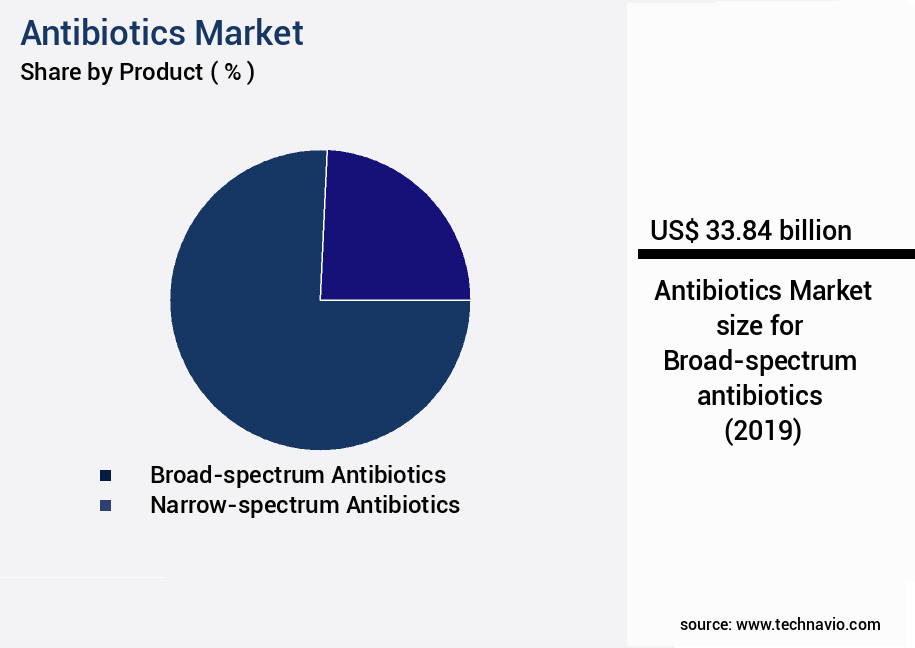
Request Free Sample
The Broad-spectrum antibiotics segment was valued at USD 33.84 billion in 2019 and showed a gradual increase during the forecast period.
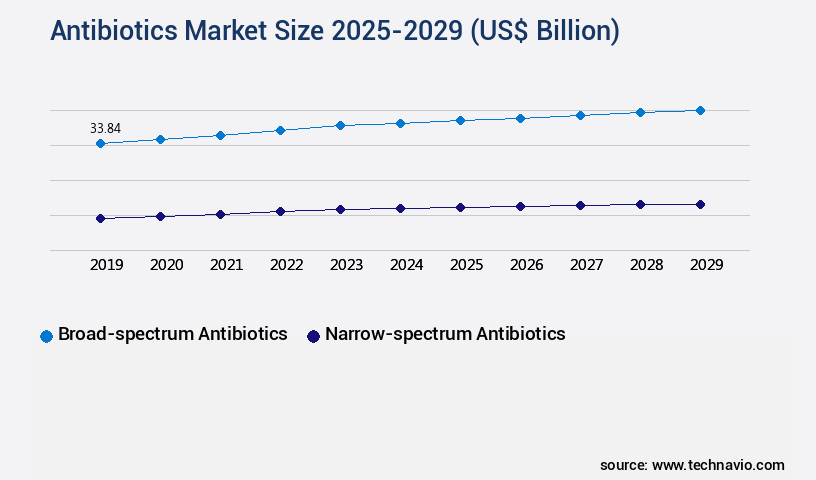
Request Free Sample
Regional Analysis
Asia is estimated to contribute 42% to the growth of the global market during the forecast period.Technavio’s analysts have elaborately explained the regional trends and drivers that shape the market during the forecast period.

See How Antibiotics Market Demand is Rising in Asia Request Free Sample
The market in Asia is experiencing significant growth, with China and Japan leading the way. In August 2023, China's State Council introduced guidelines to enhance the business environment for foreign investments in biopharmaceuticals. These measures prioritize clinical trial acceleration and expedited drug registration, attracting foreign companies to develop new antibiotics in China. In Japan, efforts are underway to reduce dependency on China for active pharmaceutical ingredients (APIs) used in antibiotics. This includes initiatives to boost domestic production and diversify suppliers. These developments are expected to increase the availability and production of new antibiotics in Asia, making it a key region in The market.
According to recent reports, the number of clinical trials for new antibiotics in China has surged by 30% year-over-year. Additionally, Japan's market for antibiotics is projected to reach USD3.5 billion by 2026, growing at a steady pace. China's market is also projected to reach USD10 billion by 2027, demonstrating the market's potential.
Market Dynamics
Our researchers analyzed the data with 2024 as the base year, along with the key drivers, trends, and challenges. A holistic analysis of drivers will help companies refine their marketing strategies to gain a competitive advantage.
The market is a critical and evolving sector, driven by the mechanisms of bacterial resistance to existing antibiotics and the impact of antibiotic usage on resistance genes. This market witnesses significant research efforts to develop novel antimicrobial peptides and evaluate antibiotic pharmacokinetic parameters. Clinical trials for new antibiotic candidates are meticulously designed to address these challenges. Moreover, understanding the role of efflux pumps in antibiotic resistance and implementing methods for detecting antibiotic resistance genes are essential components of the market. The analysis of antibiotic resistance patterns in clinical isolates and bacterial genome analysis for resistance prediction are crucial in guiding the development of strategies for combating antimicrobial resistance.
Effectiveness of combination antibiotic therapies and the impact of bacterial biofilms on antibiotic efficacy are significant concerns in the market. Identification of novel drug targets for antibiotics and the development of advanced drug delivery systems for antibiotics are key areas of innovation. Application of metagenomics in understanding antibiotic resistance and assessment of antibiotic stewardship programs are essential aspects of the market. Infection control measures to reduce antibiotic resistance and public health strategies to mitigate antibiotic resistance are gaining increasing importance. Adoption rates of advanced technologies and strategies in the market vary significantly. For instance, more than 70% of new product developments focus on personalized antibiotic treatment based on bacterial genetics, compared to less than 30% on optimization of antibiotic dosing regimens.
This comparative data underscores the market's dynamic and research-driven nature.
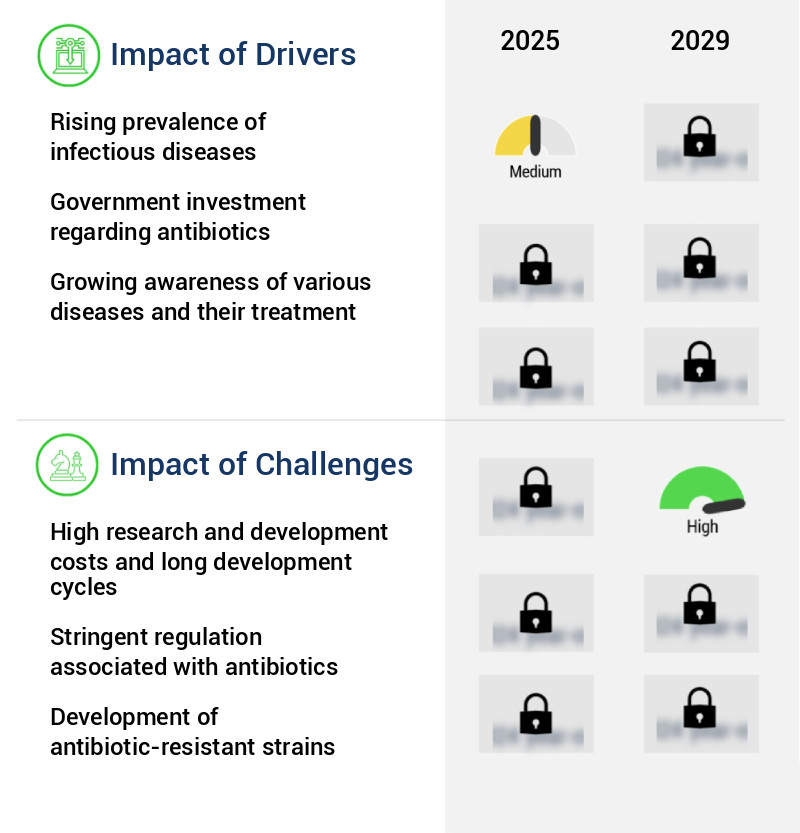
What are the key market drivers leading to the rise in the adoption of Antibiotics Industry?
- The escalating incidence of infectious diseases serves as the primary catalyst for market growth.
- The market is experiencing substantial expansion due to the persistent issue of infectious diseases worldwide. Infectious diseases continue to pose a significant public health challenge, leading to the extensive utilization of antibiotics for managing and treating these conditions effectively. For instance, in the United States, over 95% of adults have had chickenpox at some point in their lives, with approximately 4 million cases reported annually. Similarly, in Germany, the incidence of chickenpox remains high, with nearly 170 cases per 1,000 children aged between five and nine years recorded in 2023.
- The market's continuous growth can also be attributed to the development and introduction of new antibiotics, as well as the increasing awareness and emphasis on disease prevention and treatment. In the ever-evolving healthcare landscape, the market remains a crucial player in addressing the ongoing challenge of infectious diseases.
What are the market trends shaping the Antibiotics Industry?
- Strategic alliances and mergers and acquisitions are currently prevailing market trends.
(Alternatively, two lines for clarity and formal tone:)
The current market landscape is characterized by an increasing prevalence of strategic alliances and mergers and acquisitions.
(Or, if adhering to a strict 100-word limit:)
Strategic alliances and mergers and acquisitions have emerged as the dominant market trends, shaping the current business landscape.
- The market is experiencing a significant trend of increased mergers and acquisitions among major players. This strategic consolidation is primarily driven by the desire to expand market presence, enrich product offerings, and optimize operational efficiencies. For example, in May 2023, Virbac completed the acquisition of GS Partners, extending its reach into Central Europe. This deal not only broadened Virbac's geographical footprint but also fortified its capabilities in the pet and ruminant sectors. By integrating GS Partners, Virbac intends to better address the animal health needs in the Czech Republic and Slovakia, thereby strengthening its market position.
- Another key player, Merck KGaA, acquired Sigma-Aldrich in 2015, significantly expanding its life science business. These acquisitions underscore the market's dynamic nature and the continuous pursuit of growth and innovation.
What challenges does the Antibiotics Industry face during its growth?
- The high research and development costs and prolonged development cycles pose a significant challenge to the industry, impeding its growth.
- The market faces significant challenges due to the lengthy and costly process of developing new antibiotics. With an average development timeline of over a decade, these drugs undergo rigorous clinical trials to ensure safety and efficacy. Regulatory requirements add to the complexity and expense, delaying market entry. Major pharmaceutical companies, such as Pfizer Inc. And Merck and Co., Inc., invest heavily in their antibiotic pipelines, but the financial burden of research and development is substantial.
- The profitability of antibiotics is comparatively low compared to other therapeutic areas, making the market dynamic and evolving. Despite these challenges, innovation continues as researchers explore alternative approaches, including repurposing existing antibiotics and leveraging technology to streamline the development process.
Exclusive Customer Landscape
The antibiotics market forecasting report includes the adoption lifecycle of the market, covering from the innovator’s stage to the laggard’s stage. It focuses on adoption rates in different regions based on penetration. Furthermore, the antibiotics market report also includes key purchase criteria and drivers of price sensitivity to help companies evaluate and develop their market growth analysis strategies.
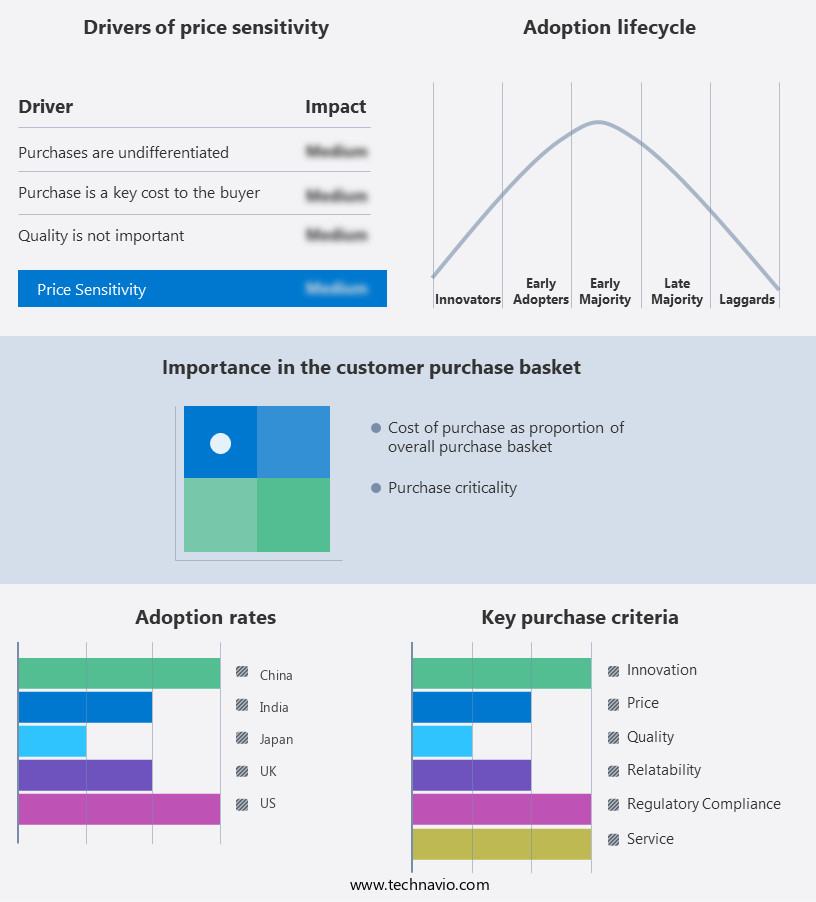
Customer Landscape of Antibiotics Industry
Competitive Landscape & Market Insights
Companies are implementing various strategies, such as strategic alliances, antibiotics market forecast, partnerships, mergers and acquisitions, geographical expansion, and product/service launches, to enhance their presence in the industry.
Abbott Laboratories - The company specializes in the development and commercialization of ACITROM antibiotics, an innovative solution targeting cardio and diabetes-related infections. This antibiotic class demonstrates potential in addressing complex bacterial complications associated with these conditions.
The industry research and growth report includes detailed analyses of the competitive landscape of the market and information about key companies, including:
- Abbott Laboratories
- AbbVie Inc.
- Armata Pharmaceuticals Inc.
- Aspen Pharmacare Holdings Ltd.
- Astellas Pharma Inc.
- Aurobindo Pharma Ltd.
- Bayer AG
- F. Hoffmann La Roche Ltd.
- Flynn Pharma Ltd.
- GlaxoSmithKline Plc
- Incepta Pharmaceuticals Ltd.
- Johnson and Johnson Services Inc.
- Lupin Ltd.
- Mayne Pharma Group Ltd.
- Melinta Therapeutics LLC
- Merck KGaA
- Pfizer Inc.
- Sanofi SA
- Takeda Pharmaceutical Co. Ltd.
- Teva Pharmaceutical Industries Ltd.
Qualitative and quantitative analysis of companies has been conducted to help clients understand the wider business environment as well as the strengths and weaknesses of key industry players. Data is qualitatively analyzed to categorize companies as pure play, category-focused, industry-focused, and diversified; it is quantitatively analyzed to categorize companies as dominant, leading, strong, tentative, and weak.
Recent Development and News in Antibiotics Market
- In January 2024, Pfizer Inc. Announced the FDA approval of its new antibiotic, Zavicefta, in collaboration with AstraZeneca. This combination drug, used to treat complicated urinary tract infections, marked a significant advancement in the market due to its potential to combat antibiotic-resistant bacteria (PR Newswire, 2024).
- In March 2024, Merck & Co. And The Medicines Company entered into a definitive agreement for Merck to acquire The Medicines Company for approximately USD9.5 billion. This strategic acquisition aimed to strengthen Merck's infectious disease portfolio, including the addition of The Medicines Company's antibiotic, Orbactiv, which targets drug-resistant bacteria (Merck, 2024).
- In May 2024, the European Commission approved the marketing authorization of Melinta Therapeutics' antibictor, Baxdela, for the treatment of acute bacterial skin and skin structure infections. This approval expanded the product's reach in Europe and further solidified Melinta's position in the market (Melinta Therapeutics, 2024).
- In April 2025, Novartis AG and the Bill & Melinda Gates Foundation announced a partnership to develop and commercialize a new class of antibiotics. The collaboration aimed to address the growing global health threat of antibiotic-resistant bacteria and bring new treatments to low- and middle-income countries (Novartis, 2025).
Dive into Technavio’s robust research methodology, blending expert interviews, extensive data synthesis, and validated models for unparalleled Antibiotics Market insights. See full methodology.
|
Market Scope
|
|
Report Coverage
|
Details
|
|
Page number
|
198
|
|
Base year
|
2024
|
|
Historic period
|
2019-2023 |
|
Forecast period
|
2025-2029
|
|
Growth momentum & CAGR
|
Accelerate at a CAGR of 5.9%
|
|
Market growth 2025-2029
|
USD 18.22 billion
|
|
Market structure
|
Fragmented
|
|
YoY growth 2024-2025(%)
|
5.5
|
|
Key countries
|
US, China, Japan, Canada, India, South Korea, Germany, France, Brazil, and Indonesia
|
|
Competitive landscape
|
Leading Companies, Market Positioning of Companies, Competitive Strategies, and Industry Risks
|
Request Free Sample
Research Analyst Overview
- The market is a dynamic and evolving landscape shaped by ongoing advancements in infection prevention practices and clinical microbiology labs. Whole genome sequencing plays a pivotal role in understanding antibiotic pharmacokinetics and resistance mechanisms, revealing insights into DNA gyrase inhibitors, dosage optimization strategies, and target site modification. Horizontal gene transfer and antimicrobial peptide synthesis are among the innovative approaches addressing the challenge of antibiotic resistance. Infection control protocols and metagenomic analysis tools are essential in monitoring antibiotic resistance prediction, minimum inhibitory concentration, and antibiotic susceptibility testing. Therapeutic drug monitoring and antibiotic pharmacodynamics are critical components of personalized patient-specific treatment, ensuring optimal therapeutic outcomes.
- Protein synthesis inhibitors and RNA polymerase inhibitors are among the classes of antibiotics undergoing extensive research, with a focus on target site modification and antimicrobial resistance genes. Beta-lactam antibiotic resistance, driven by drug metabolism enzymes, necessitates the development of combination antibiotic therapy and resistance surveillance systems. Efflux pump mechanisms and genetic sequencing methods contribute to the understanding of drug resistance mutations, enabling the design of novel antibiotics and therapeutic strategies. Microbial pathogenesis and infection control guidelines continue to shape the market, with ongoing research and innovation driving its evolution.
What are the Key Data Covered in this Antibiotics Market Research and Growth Report?
-
What is the expected growth of the Antibiotics Market between 2025 and 2029?
-
What segmentation does the market report cover?
-
The report segmented by Product (Broad-spectrum antibiotics and Narrow-spectrum antibiotics), Route Of Administration (Intravenous, Oral, and Others), and Geography (Asia, North America, Europe, and Rest of World (ROW))
-
Which regions are analyzed in the report?
-
What are the key growth drivers and market challenges?
-
Who are the major players in the Antibiotics Market?
-
Key Companies Abbott Laboratories, AbbVie Inc., Armata Pharmaceuticals Inc., Aspen Pharmacare Holdings Ltd., Astellas Pharma Inc., Aurobindo Pharma Ltd., Bayer AG, F. Hoffmann La Roche Ltd., Flynn Pharma Ltd., GlaxoSmithKline Plc, Incepta Pharmaceuticals Ltd., Johnson and Johnson Services Inc., Lupin Ltd., Mayne Pharma Group Ltd., Melinta Therapeutics LLC, Merck KGaA, Pfizer Inc., Sanofi SA, Takeda Pharmaceutical Co. Ltd., and Teva Pharmaceutical Industries Ltd.
Market Research Insights
- The market is a dynamic and complex ecosystem, characterized by ongoing research and development efforts to address the challenges posed by bacterial virulence factors, bacterial persistence mechanisms, and antibiotic resistance spread. Two significant statistics illustrate the market's evolving nature. First, antibiotic half-life, a measure of how long an antibiotic remains effective in the body, has been decreasing due to the emergence of antibiotic resistance. For instance, the average half-life of penicillin has dropped from 36 hours in the 1940s to just 2 hours today. Second, the microbial community structure of infections is increasingly recognized as a critical factor in antibiotic efficacy.
- Studies have shown that the presence of certain bacterial species can reduce the effectiveness of antibiotics by up to 50%. As a result, there is growing interest in developing new antibiotic development strategies, such as synthetic antibiotic design, novel antimicrobial agents, and personalized medicine approaches, to address these challenges and improve infection treatment outcomes. Antibiotic tolerance mechanisms, drug interaction profiles, and drug delivery systems are also under active investigation to enhance antibiotic efficacy and reduce resistance. Clinical trial outcomes and infection risk factors continue to inform the development of new antibiotic treatment strategies and biofilm eradication methods.
We can help! Our analysts can customize this antibiotics market research report to meet your requirements.
Get in touch
1 Executive Summary
- 1.1 Market overview
- Executive Summary - Chart on Market Overview
- Executive Summary - Data Table on Market Overview
- Executive Summary - Chart on Global Market Characteristics
- Executive Summary - Chart on Market by Geography
- Executive Summary - Chart on Market Segmentation by Product
- Executive Summary - Chart on Market Segmentation by Route of Administration
- Executive Summary - Chart on Incremental Growth
- Executive Summary - Data Table on Incremental Growth
- Executive Summary - Chart on Company Market Positioning
2 Technavio Analysis
- 2.1 Analysis of price sensitivity, lifecycle, customer purchase basket, adoption rates, and purchase criteria
- Analysis of price sensitivity, lifecycle, customer purchase basket, adoption rates, and purchase criteria
- 2.2 Criticality of inputs and Factors of differentiation
- Overview on criticality of inputs and factors of differentiation
- 2.3 Factors of disruption
- Overview on factors of disruption
- 2.4 Impact of drivers and challenges
- Impact of drivers and challenges in 2024 and 2029
3 Market Landscape
- 3.1 Market ecosystem
- Parent Market
- Data Table on - Parent Market
- 3.2 Market characteristics
- Market characteristics analysis
4 Market Sizing
- 4.1 Market definition
- Offerings of companies included in the market definition
- 4.2 Market segment analysis
- 4.4 Market outlook: Forecast for 2024-2029
- Chart on Global - Market size and forecast 2024-2029 ($ billion)
- Data Table on Global - Market size and forecast 2024-2029 ($ billion)
- Chart on Global Market: Year-over-year growth 2024-2029 (%)
- Data Table on Global Market: Year-over-year growth 2024-2029 (%)
5 Historic Market Size
- 5.1 Global Antibiotics Market 2019 - 2023
- Historic Market Size - Data Table on Global Antibiotics Market 2019 - 2023 ($ billion)
- 5.2 Product segment analysis 2019 - 2023
- Historic Market Size - Product Segment 2019 - 2023 ($ billion)
- 5.3 Route of Administration segment analysis 2019 - 2023
- Historic Market Size - Route of Administration Segment 2019 - 2023 ($ billion)
- 5.4 Geography segment analysis 2019 - 2023
- Historic Market Size - Geography Segment 2019 - 2023 ($ billion)
- 5.5 Country segment analysis 2019 - 2023
- Historic Market Size - Country Segment 2019 - 2023 ($ billion)
6 Qualitative Analysis
- 6.1 Impact of AI on Global Antibiotics Market
7 Five Forces Analysis
- 7.1 Five forces summary
- Five forces analysis - Comparison between 2024 and 2029
- 7.2 Bargaining power of buyers
- Bargaining power of buyers - Impact of key factors 2024 and 2029
- 7.3 Bargaining power of suppliers
- Bargaining power of suppliers - Impact of key factors in 2024 and 2029
- 7.4 Threat of new entrants
- Threat of new entrants - Impact of key factors in 2024 and 2029
- 7.5 Threat of substitutes
- Threat of substitutes - Impact of key factors in 2024 and 2029
- 7.6 Threat of rivalry
- Threat of rivalry - Impact of key factors in 2024 and 2029
- 7.7 Market condition
- Chart on Market condition - Five forces 2024 and 2029
8 Market Segmentation by Product
- 8.1 Market segments
- Chart on Product - Market share 2024-2029 (%)
- Data Table on Product - Market share 2024-2029 (%)
- 8.2 Comparison by Product
- Chart on Comparison by Product
- Data Table on Comparison by Product
- 8.3 Broad-spectrum - Market size and forecast 2024-2029
- Chart on Broad-spectrum - Market size and forecast 2024-2029 ($ billion)
- Data Table on Broad-spectrum - Market size and forecast 2024-2029 ($ billion)
- Chart on Broad-spectrum - Year-over-year growth 2024-2029 (%)
- Data Table on Broad-spectrum - Year-over-year growth 2024-2029 (%)
- 8.4 Narrow-spectrum - Market size and forecast 2024-2029
- Chart on Narrow-spectrum - Market size and forecast 2024-2029 ($ billion)
- Data Table on Narrow-spectrum - Market size and forecast 2024-2029 ($ billion)
- Chart on Narrow-spectrum - Year-over-year growth 2024-2029 (%)
- Data Table on Narrow-spectrum - Year-over-year growth 2024-2029 (%)
- 8.5 Market opportunity by Product
- Market opportunity by Product ($ billion)
- Data Table on Market opportunity by Product ($ billion)
9 Market Segmentation by Route of Administration
- 9.1 Market segments
- Chart on Route of Administration - Market share 2024-2029 (%)
- Data Table on Route of Administration - Market share 2024-2029 (%)
- 9.2 Comparison by Route of Administration
- Chart on Comparison by Route of Administration
- Data Table on Comparison by Route of Administration
- 9.3 Intravenous - Market size and forecast 2024-2029
- Chart on Intravenous - Market size and forecast 2024-2029 ($ billion)
- Data Table on Intravenous - Market size and forecast 2024-2029 ($ billion)
- Chart on Intravenous - Year-over-year growth 2024-2029 (%)
- Data Table on Intravenous - Year-over-year growth 2024-2029 (%)
- 9.4 Oral - Market size and forecast 2024-2029
- Chart on Oral - Market size and forecast 2024-2029 ($ billion)
- Data Table on Oral - Market size and forecast 2024-2029 ($ billion)
- Chart on Oral - Year-over-year growth 2024-2029 (%)
- Data Table on Oral - Year-over-year growth 2024-2029 (%)
- 9.5 Others - Market size and forecast 2024-2029
- Chart on Others - Market size and forecast 2024-2029 ($ billion)
- Data Table on Others - Market size and forecast 2024-2029 ($ billion)
- Chart on Others - Year-over-year growth 2024-2029 (%)
- Data Table on Others - Year-over-year growth 2024-2029 (%)
- 9.6 Market opportunity by Route of Administration
- Market opportunity by Route of Administration ($ billion)
- Data Table on Market opportunity by Route of Administration ($ billion)
10 Customer Landscape
- 10.1 Customer landscape overview
- Analysis of price sensitivity, lifecycle, customer purchase basket, adoption rates, and purchase criteria
11 Geographic Landscape
- 11.1 Geographic segmentation
- Chart on Market share by geography 2024-2029 (%)
- Data Table on Market share by geography 2024-2029 (%)
- 11.2 Geographic comparison
- Chart on Geographic comparison
- Data Table on Geographic comparison
- 11.3 Asia - Market size and forecast 2024-2029
- Chart on Asia - Market size and forecast 2024-2029 ($ billion)
- Data Table on Asia - Market size and forecast 2024-2029 ($ billion)
- Chart on Asia - Year-over-year growth 2024-2029 (%)
- Data Table on Asia - Year-over-year growth 2024-2029 (%)
- 11.4 North America - Market size and forecast 2024-2029
- Chart on North America - Market size and forecast 2024-2029 ($ billion)
- Data Table on North America - Market size and forecast 2024-2029 ($ billion)
- Chart on North America - Year-over-year growth 2024-2029 (%)
- Data Table on North America - Year-over-year growth 2024-2029 (%)
- 11.5 Europe - Market size and forecast 2024-2029
- Chart on Europe - Market size and forecast 2024-2029 ($ billion)
- Data Table on Europe - Market size and forecast 2024-2029 ($ billion)
- Chart on Europe - Year-over-year growth 2024-2029 (%)
- Data Table on Europe - Year-over-year growth 2024-2029 (%)
- 11.6 Rest of World (ROW) - Market size and forecast 2024-2029
- Chart on Rest of World (ROW) - Market size and forecast 2024-2029 ($ billion)
- Data Table on Rest of World (ROW) - Market size and forecast 2024-2029 ($ billion)
- Chart on Rest of World (ROW) - Year-over-year growth 2024-2029 (%)
- Data Table on Rest of World (ROW) - Year-over-year growth 2024-2029 (%)
- 11.7 US - Market size and forecast 2024-2029
- Chart on US - Market size and forecast 2024-2029 ($ billion)
- Data Table on US - Market size and forecast 2024-2029 ($ billion)
- Chart on US - Year-over-year growth 2024-2029 (%)
- Data Table on US - Year-over-year growth 2024-2029 (%)
- 11.8 China - Market size and forecast 2024-2029
- Chart on China - Market size and forecast 2024-2029 ($ billion)
- Data Table on China - Market size and forecast 2024-2029 ($ billion)
- Chart on China - Year-over-year growth 2024-2029 (%)
- Data Table on China - Year-over-year growth 2024-2029 (%)
- 11.9 Japan - Market size and forecast 2024-2029
- Chart on Japan - Market size and forecast 2024-2029 ($ billion)
- Data Table on Japan - Market size and forecast 2024-2029 ($ billion)
- Chart on Japan - Year-over-year growth 2024-2029 (%)
- Data Table on Japan - Year-over-year growth 2024-2029 (%)
- 11.10 Canada - Market size and forecast 2024-2029
- Chart on Canada - Market size and forecast 2024-2029 ($ billion)
- Data Table on Canada - Market size and forecast 2024-2029 ($ billion)
- Chart on Canada - Year-over-year growth 2024-2029 (%)
- Data Table on Canada - Year-over-year growth 2024-2029 (%)
- 11.11 India - Market size and forecast 2024-2029
- Chart on India - Market size and forecast 2024-2029 ($ billion)
- Data Table on India - Market size and forecast 2024-2029 ($ billion)
- Chart on India - Year-over-year growth 2024-2029 (%)
- Data Table on India - Year-over-year growth 2024-2029 (%)
- 11.12 South Korea - Market size and forecast 2024-2029
- Chart on South Korea - Market size and forecast 2024-2029 ($ billion)
- Data Table on South Korea - Market size and forecast 2024-2029 ($ billion)
- Chart on South Korea - Year-over-year growth 2024-2029 (%)
- Data Table on South Korea - Year-over-year growth 2024-2029 (%)
- 11.13 Germany - Market size and forecast 2024-2029
- Chart on Germany - Market size and forecast 2024-2029 ($ billion)
- Data Table on Germany - Market size and forecast 2024-2029 ($ billion)
- Chart on Germany - Year-over-year growth 2024-2029 (%)
- Data Table on Germany - Year-over-year growth 2024-2029 (%)
- 11.14 Brazil - Market size and forecast 2024-2029
- Chart on Brazil - Market size and forecast 2024-2029 ($ billion)
- Data Table on Brazil - Market size and forecast 2024-2029 ($ billion)
- Chart on Brazil - Year-over-year growth 2024-2029 (%)
- Data Table on Brazil - Year-over-year growth 2024-2029 (%)
- 11.15 France - Market size and forecast 2024-2029
- Chart on France - Market size and forecast 2024-2029 ($ billion)
- Data Table on France - Market size and forecast 2024-2029 ($ billion)
- Chart on France - Year-over-year growth 2024-2029 (%)
- Data Table on France - Year-over-year growth 2024-2029 (%)
- 11.16 Indonesia - Market size and forecast 2024-2029
- Chart on Indonesia - Market size and forecast 2024-2029 ($ billion)
- Data Table on Indonesia - Market size and forecast 2024-2029 ($ billion)
- Chart on Indonesia - Year-over-year growth 2024-2029 (%)
- Data Table on Indonesia - Year-over-year growth 2024-2029 (%)
- 11.17 Market opportunity by geography
- Market opportunity by geography ($ billion)
- Data Tables on Market opportunity by geography ($ billion)
12 Drivers, Challenges, and Opportunity/Restraints
- 12.3 Impact of drivers and challenges
- Impact of drivers and challenges in 2024 and 2029
- 12.4 Market opportunities/restraints
13 Competitive Landscape
- 13.2 Competitive Landscape
- Overview on criticality of inputs and factors of differentiation
- 13.3 Landscape disruption
- Overview on factors of disruption
- 13.4 Industry risks
- Impact of key risks on business
14 Competitive Analysis
- 14.2 Company ranking index
- 14.3 Market positioning of companies
- Matrix on companies position and classification
- 14.4 Abbott Laboratories
- Abbott Laboratories - Overview
- Abbott Laboratories - Business segments
- Abbott Laboratories - Key news
- Abbott Laboratories - Key offerings
- Abbott Laboratories - Segment focus
- SWOT
- 14.5 AbbVie Inc.
- AbbVie Inc. - Overview
- AbbVie Inc. - Product / Service
- AbbVie Inc. - Key news
- AbbVie Inc. - Key offerings
- SWOT
- 14.6 Aspen Pharmacare Holdings Ltd.
- Aspen Pharmacare Holdings Ltd. - Overview
- Aspen Pharmacare Holdings Ltd. - Business segments
- Aspen Pharmacare Holdings Ltd. - Key offerings
- Aspen Pharmacare Holdings Ltd. - Segment focus
- SWOT
- 14.7 Astellas Pharma Inc.
- Astellas Pharma Inc. - Overview
- Astellas Pharma Inc. - Product / Service
- Astellas Pharma Inc. - Key offerings
- SWOT
- 14.8 Aurobindo Pharma Ltd.
- Aurobindo Pharma Ltd. - Overview
- Aurobindo Pharma Ltd. - Product / Service
- Aurobindo Pharma Ltd. - Key offerings
- SWOT
- 14.9 Bayer AG
- Bayer AG - Overview
- Bayer AG - Business segments
- Bayer AG - Key offerings
- Bayer AG - Segment focus
- SWOT
- 14.10 F. Hoffmann La Roche Ltd.
- F. Hoffmann La Roche Ltd. - Overview
- F. Hoffmann La Roche Ltd. - Business segments
- F. Hoffmann La Roche Ltd. - Key news
- F. Hoffmann La Roche Ltd. - Key offerings
- F. Hoffmann La Roche Ltd. - Segment focus
- SWOT
- 14.11 GlaxoSmithKline Plc
- GlaxoSmithKline Plc - Overview
- GlaxoSmithKline Plc - Business segments
- GlaxoSmithKline Plc - Key news
- GlaxoSmithKline Plc - Key offerings
- GlaxoSmithKline Plc - Segment focus
- SWOT
- 14.12 Incepta Pharmaceuticals Ltd.
- Incepta Pharmaceuticals Ltd. - Overview
- Incepta Pharmaceuticals Ltd. - Product / Service
- Incepta Pharmaceuticals Ltd. - Key offerings
- SWOT
- 14.13 Johnson and Johnson Services Inc.
- Johnson and Johnson Services Inc. - Overview
- Johnson and Johnson Services Inc. - Business segments
- Johnson and Johnson Services Inc. - Key news
- Johnson and Johnson Services Inc. - Key offerings
- Johnson and Johnson Services Inc. - Segment focus
- SWOT
- 14.14 Lupin Ltd.
- Lupin Ltd. - Overview
- Lupin Ltd. - Business segments
- Lupin Ltd. - Key news
- Lupin Ltd. - Key offerings
- Lupin Ltd. - Segment focus
- SWOT
- 14.15 Mayne Pharma Group Ltd.
- Mayne Pharma Group Ltd. - Overview
- Mayne Pharma Group Ltd. - Business segments
- Mayne Pharma Group Ltd. - Key news
- Mayne Pharma Group Ltd. - Key offerings
- Mayne Pharma Group Ltd. - Segment focus
- SWOT
- 14.16 Merck KGaA
- Merck KGaA - Overview
- Merck KGaA - Business segments
- Merck KGaA - Key news
- Merck KGaA - Key offerings
- Merck KGaA - Segment focus
- SWOT
- 14.17 Pfizer Inc.
- Pfizer Inc. - Overview
- Pfizer Inc. - Product / Service
- Pfizer Inc. - Key news
- Pfizer Inc. - Key offerings
- SWOT
- 14.18 Sanofi SA
- Sanofi SA - Overview
- Sanofi SA - Business segments
- Sanofi SA - Key news
- Sanofi SA - Key offerings
- Sanofi SA - Segment focus
- SWOT
15 Appendix
- 15.2 Inclusions and exclusions checklist
- Inclusions checklist
- Exclusions checklist
- 15.3 Currency conversion rates for US$
- Currency conversion rates for US$
- 15.4 Research methodology
- 15.7 Validation techniques employed for market sizing
- Validation techniques employed for market sizing
- 15.9 360 degree market analysis
- 360 degree market analysis
- 15.10 List of abbreviations







![]() Get the report (PDF) sent to your email within minutes.
Get the report (PDF) sent to your email within minutes.
Complimentary full Excel data with your report purchase.